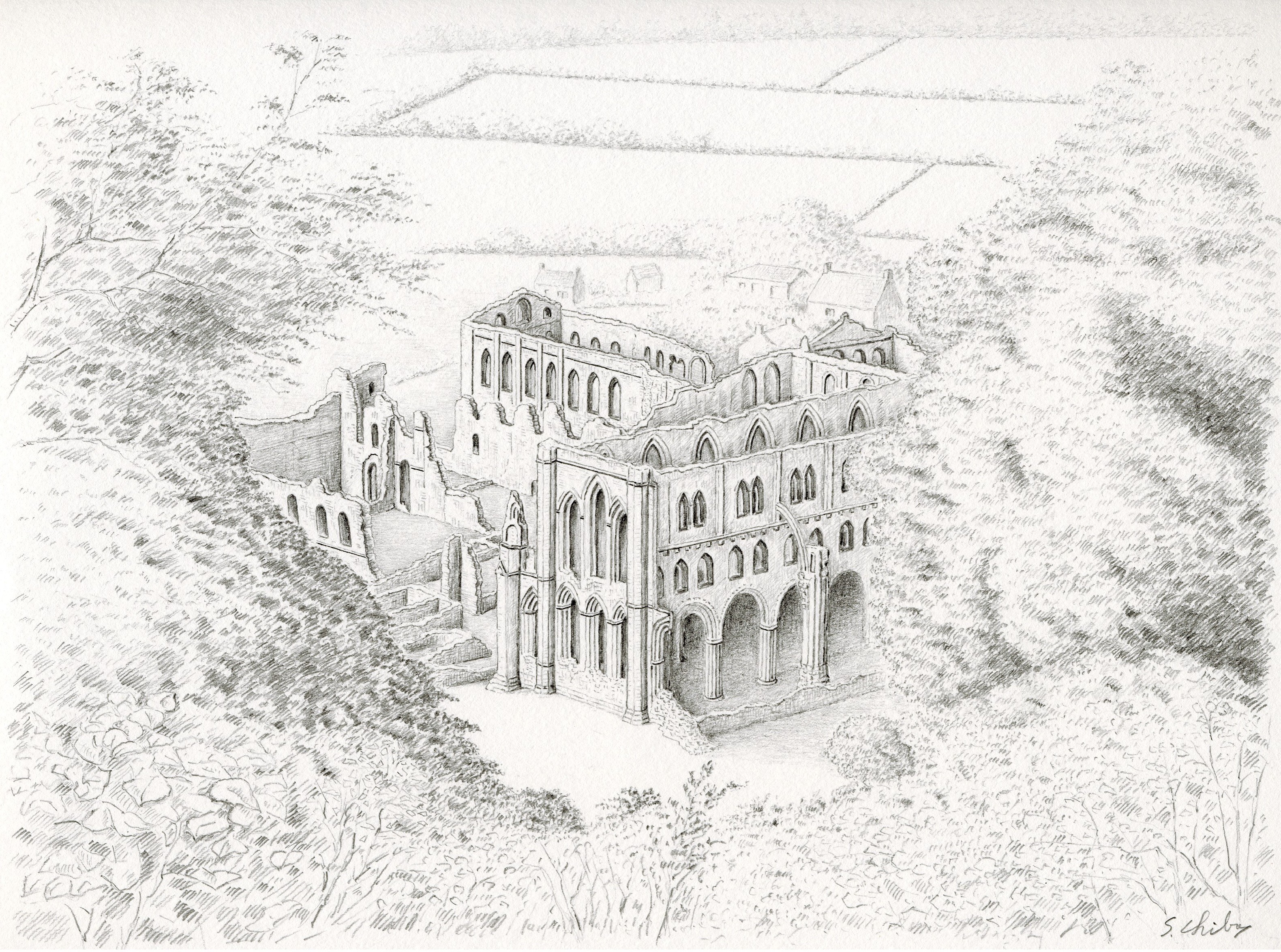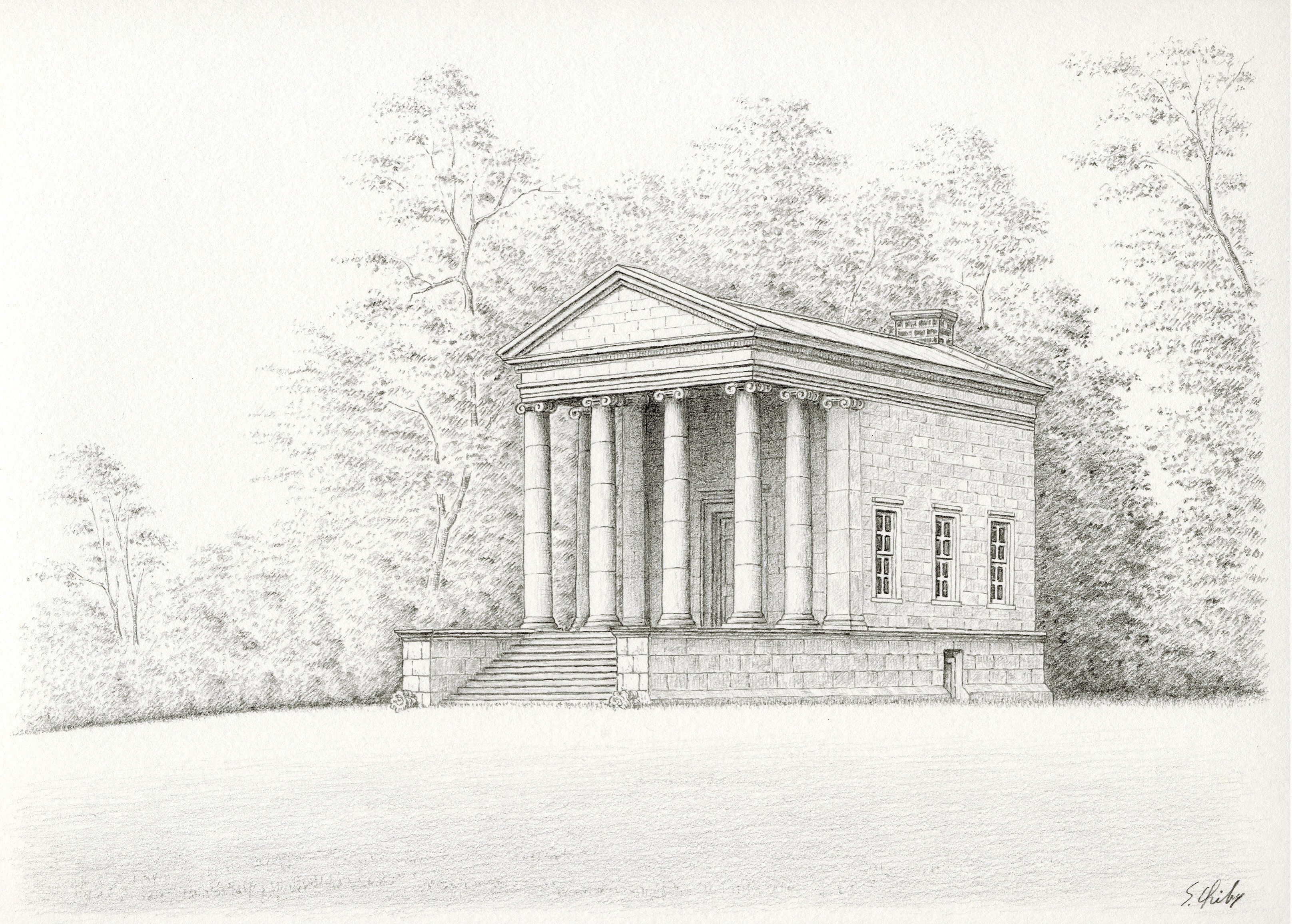
遥かなる わがヨークシャー (Faraway My Yorkshire)
ノース・ヨーク・ムーアズ (The North York Moors)
75 リーヴォ修道院 [ヘルムズリー近く] (Rievaulx Abbey, near Helmsley)

バイランド修道院から北へ6kmほど行ったハンブルトン丘陵のなかに、リーヴォ修道院の廃墟がある。
この廃墟でまず目につくのが、太い柱と美しいアーチの重なりである。聖堂の外壁が崩れ落ちているために、剥き出しとなったアーケイド(側廊のアーチの連なり)、その上のトライフォーリアム(小さなアーチの連なった中間層)、さあらにその上のクリアストーリ(高窓のアーチがならんだ側壁)と、アーチが3層になって重なっているのが見えるのである。
それらのアーチは、上へゆくほどに小さくなり、優雅に、リズミカルにくりかえされる。柱とアーチは、フルートという縦の線が何本も刻まれている。それらの線には、ギリシャ神話の女神が身につけている衣のひだを思わせるものがあり、この廃墟に流麗な美しさをあたえている。
ファウンテンズ修道院(水彩画28)の廃墟には、壮大で壮麗な男性的な造形美がある。これにたいしてリーヴォ修道院にあるものは、優雅で流麗な、女性的な美しさである。
身廊内陣の北側(ふつう聖堂は東西方向に建てられているが、ここではほとんど南北方向に建てられているので、実際には東側になる)の外には、フライング・バットレス(飛び梁という、聖堂上部の外壁を外からささえるために、下から上へ斜めにのびている補強構造のこと)の名残も見られる。
リーヴォ修道院は、1131年に建設がはじまって13世紀に完成したところで、シスターシャンの修道院としては、イングランドでも2番目に古い修道院とされる。ちなみにもっとも古いものは、3年前の1128年にサリー州で建設がはじまったウェイヴァリー修道院である。
リーヴォ修道院が解散させられたのは1539年のことで、その後、廃墟になっていった。そしていまは、屋根がすっかり落ち、かつての身廊内陣と南北の翼廊の壁だけが残っている。身廊外陣は、外壁のほんの一部と、基礎の石を残すのみである。
建築様式的に見れば、大部分がノルマン様式で、最後に建てられた聖堂内陣の部分が、ゴシック様式のなかの初期イギリス様式というものになっている。
この修道院の歴史でもっとも名高い院長、聖アイルレッドの時代の1165年の記録によれば、「リーヴォ修道院には140人の修道士と少なくとも500人の平修士がおり、さながら蜜蜂の巣箱のようであった」という。
この記録からは、きびしい戒律のもと、祈りと労働をとおして修行にはげむ静かな生活の場、という修道院のイメージとはことなり、当時の修道院が、けっこう活気にあふれ、にぎやかなところであったことがうかがえる。
平修士(レイ・ブラザー)とは修道院で働く労働者のことで、学僧である修道士とは身分がまったくことなり、もっぱら農作業などの単純な肉体労働に従事していた。
ファウンテンズ修道院はここよりも規模が大きかったので、さらに多くの修道士や平修士がいたと想像される。
廃墟の東側には、一段、高くなった段丘がある。そこに、リーヴォ・テラスという、18世紀につくられた風景式庭園がある。10月の後半にリーヴォ修道院を訪れたとき、そこへ登ってみた。秋の白い冷たい空気が静かに流れるなか、木々のあいだから見える廃墟は、幻想的であった。城の廃墟とはことなり、修道院の廃墟にあるものは、なぜか哀しさをさそうような美しさである。
廃墟に降り、夕闇が迫るなかそこに佇んでいると、修道士たちの夕べの祈りが聞こえてきそうであった。

リーヴォ・テラスからのリーヴォ修道院の眺め
(The View of Rievaulx Abbey from Rievaulx Terrace)
About 4 miles north of Byland Abbey, there are the ruins of Rievaulx Abbey.
The moment I saw the ruins, my eyes were caught by the thick columns and beautiful arches. As the outer walls had fallen down completly, I coud see the columns and arches of arcades of the inside. I was able to appreciate the three storied structure of the church very well, which was consisted of arcades, triforiums and clerestories.
The arches of arcades, triforiums and clerestories become smaller as they
go upwards, rhythmically and elegantly. The beautiful lines of fluted columns
and arches reminded me of the gathers of robes which the Goddesses of Greek
myths wear.
While the ruins of Fountains Abbey have sturdy and dignified beauty of
the masculine form, I can say, those of Rievaulx Abbey have the refined
and graceful beauty of the feminine form.
In the north (actually almost east) outside of the presbytery, I coud see
the traces of flying buttresses too.
Rievaulx Abbey was founded in 1131, the second oldest Cistercian abbey
in England, and completed in the 13th century. (The oldest one is Waverley
Abbey founded ihn 1128 in Surrey.) It was 1539 when this abbey was dissolved
to become ruins. Most parts of the church were built in the Norman style.
The presbytery which was the last parts to be built is in the Early English
style.
The record says there were 140 monks and 500 lay brothers at Rievaulx during
the days of the most famous abbot, St Ailred, in 1165. Fountaoins Abbey
was larger thab Rievaulx, so there would be more monks and lay brothers
there.
When I visited here in late October, I climbed Rievaulx Terrace, the landscaped
garden spread on the hill on the east of the ruins. The view of the ruins
from the Terrace through the boughs and branches of trees was fantastic.
At twilight I could imagine the Vespers sounding from the ruins.

リーヴォ・テラスのギリシャ神殿
(The Temple of Rievaulx Terrace)